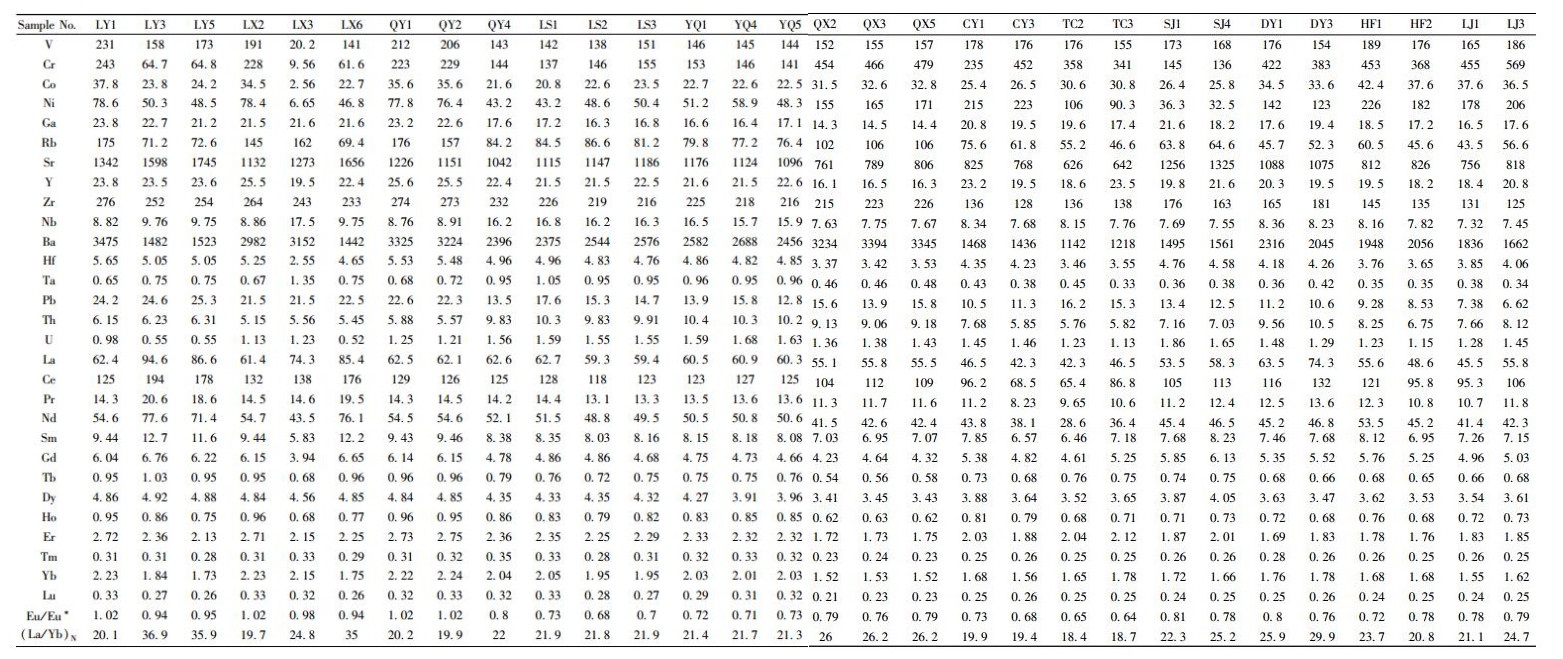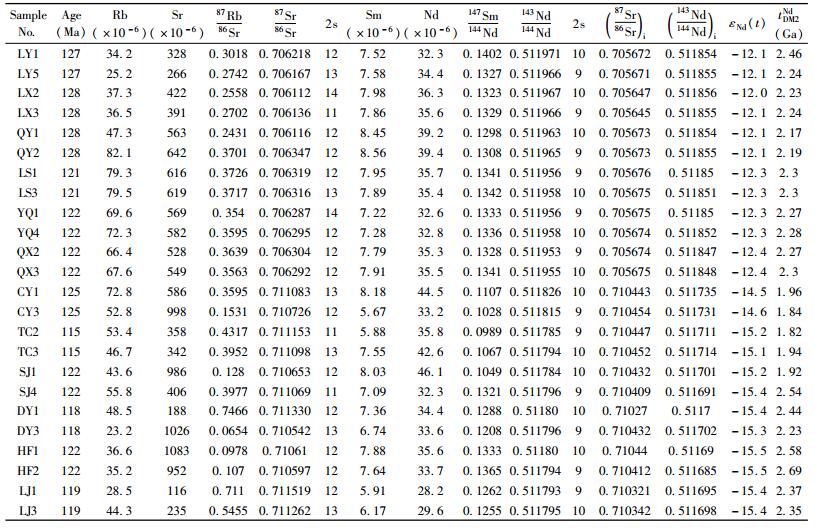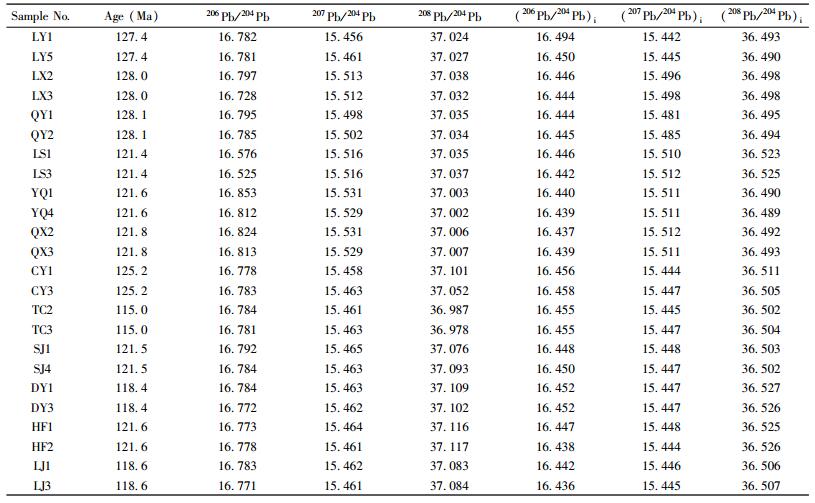2. Institute of Geology, Chinese Academy of Geological Sciences, Beijing 100037, China;
3. Institute of Geochemistry, Chinese Academy of Sciences, Guiyang 550002, China
2. 中国地质科学院地质研究所, 北京 100037;
3. 中国科学院地球化学研究所, 贵阳 550002
As one peculiar area and the most stable region of a continent, Archean cratons contain light, cold, and very thick (>200km) lithosphere. While there is no evidence of tectono-magmatic activity, mineralization, or seismicity in most old cratons (Van der Hilst and McDonough, 1999; Sleep, 2003, 2005; Carlson et al., 2005; King, 2005), the North China Craton (NCC), with a thickness of ca. 60~80km (Menzies et al., 1993; Griffin et al., 1998; Rudnick et al., 2004; Xu, 2007) and an age of >3.8Ga (Liu et al., 1992). The most striking features of the NCC are the gravity anomalies within the Taihang-Da Hinggan Mountain gravity lineament and the Tan-Lu Fault.
In the Late Mesozoic, large-scale volcanic rocks in the Taihang-Da Hinggan Mountain belt and Tan-Lu magmatic belts have been reported (Ma, 1997; Su et al., 1999; Xie et al., 2007; Tang et al., 2008; Cao, 2009; Fu, 2013; Wu et al., 2013; Cao et al., 2014). Moreover, the NCC was within an extensional setting, as indicated by presence of large-scale extensional basins (e.g., the Haogou, Guzhen, Pingyi, Mengyin, Jiyang, and Liaoxi basins; Meng, 2003), detachment fault zones (e.g., the Dayingzi Fault zone), and metamorphic core complexes (e.g., Hohhot, Yunmeng mountain, Waziyu in West Liaoning Province, South Liaoning Province, Lesser Qinling, and Song-Liao; Yang and Li, 2008). Mesozoic mafic dykes (e.g., diorite, lamprophyre, and diabase porphyry dykes) were produced in an extensional setting, with more than 300 mafic dykes dispersed throughout the NCC. It is generally accepted that these dykes yield important information on the evolution of the lithosphere including its extensional characteristics, mantle compositions, and temporal and spatial evolution. Despite this, few studies have examined these dykes. Nevertheless, the mafic rocks have only rarely been reported from two regions.
The mafic dykes are dominantly dolerite and lamprophyre, along with minor porphyritic diabase, and they generally occur in NE-SW, E-W, and N-S trending dyke swarms. Here, we report new representative zircon U-Pb ages, and geochemical and Sr-Nd-Pb isotopic data for mafic dykes from the Taihang-Da Hinggan Mountain gravity lineament (Fig. 1a-c) and the Tan-Lu Fault zone (Fig. 1d). These data provide insights into the timing, source, and origin of the dykes, and enable an assessment of the geodynamic processes that led to this magmatism. They also provide evidence of the tectonic setting of the magmatism within the magmatic Taihang-Da Hinggan Mountain belt and Tan-Lu Fault zone.
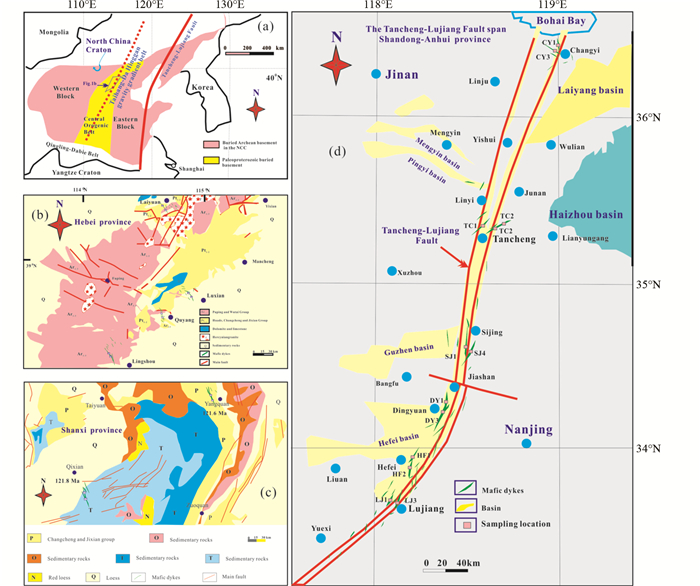
|
Figure 1 Simplified tectonic map of the area surrounding the Taihang-Da Hinggan Mountain belt, containing anomalous gravity gradients, and the Tan-Lu Fault zone Mafic dykes are concentrated at the anomalous gravity gradients and along the fault |
The NCC is located in northern China and covers an area of ~1.7 million km2 (Zhai and Santosh, 2011, 2013; Li et al., 2013; Zheng et al., 2013). It is bounded by the Yinshan-Yanshan orogenic belt to the north and the Qingling-Dabie orogenic belt to the south. The most commonly employed model of the NCC comprises uniform Precambrian (Archaean-Sinian) crystalline basement overlain by a variety of Cambrian-Quaternary cover rocks. The NCC can be divided into the Eastern, Western, and Central blocks (Zhao et al., 2001), and the Eastern and Western blocks can be further subdivided into micro-continental blocks and active belts (Zhai et al., 2000). The NCC is gravity anomalies within the Taihang-Da Hinggan Mountain belt are located between the NCC and the Erdos Plateau. They span both the NCC and the Hercynian Xingmeng orogenic belt, and are connected to the Yanshanian belt in the north and the Qinling-Dabie tectonic belt in the south. The Taihang-Da Hinggan Mountain belt is also proximal to the Pacific tectonic belt and its numerous associated major NNE-SSW trending Faults.
Another striking feature of the NCC is the Tan-Lu Fault zone of the Eastern Block. This Fault begins under the western Pacific Ocean and extends into eastern China (Zhao, 2014). It trends NNE-SSW and stretches for more than 2400km, passing through Hubei, Anhui, Jiansu, and Shandong provinces, through the Gulf of Bohai, and into northeastern China. The Tan-Lu Fault zone also cuts the Yangtze Craton and the Xingmeng-Jihei-Dabie-Sulu orogenic belts. Movement on the Fault was mainly strike-slip during the Late Jurassic to Early Cretaceous, but has changed to compression since the Neogene (Wang et al., 2006). The Tan-Lu Fault zone has been the subject of long-term (ca. 40 years) study, reflecting its importance in the regional geological framework (Zhu et al., 2010).
3 PetrographyMafic dykes are widespread throughout the 12 counties that form the focus of this study (i.e., Laiyuan, Luxian, Quyang, Lingshou, Yangquan, Qixian, Changyi, Tancheng, Sijing, Dingyuan, Hefei, Lujiang counties), in Hebei, Shanxi, Shandong, and Anhui provinces of the NCC (Fig. 1a-d). This area contains granite, monzonite, gabbro, and gneissic country rocks, all intruded by mafic dykes. However, the majority of the dykes are hosted in the granite and monzonite units. Individual mafic dykes are vertical and strike NE-SW, E-W, and N-S (Fig. 1a-d). They are 8~15m wide, 3.0~40km long (Fig. 1a-d). The studied dykes can been divided into NE (the Taihang-Da Hinggan Mountain gravity lineament)-and NW (the Tan-Lu Fault)-trending two categories.
The NE-trending mafic dykes (Laiyuan, Luxian, Quyang, Lingshou, Yangquan, Qixian) (Fig. 2a, c, d) from the Taihang-Da Hinggan Mountain gravity lineament are hosted in monzonites and granites, are vertical, and strike from E-W to NW-SE. They are 10~130m wide and 5~60km long. They contain 30%~36% micro-phenocrysts (0.5~1.3mm across) of clinopyroxene and plagioclase, alkali feldspar, and plagioclase, along with minor biotite, within a groundmass of pyroxene, plagioclase, magnetite, and chlorite.
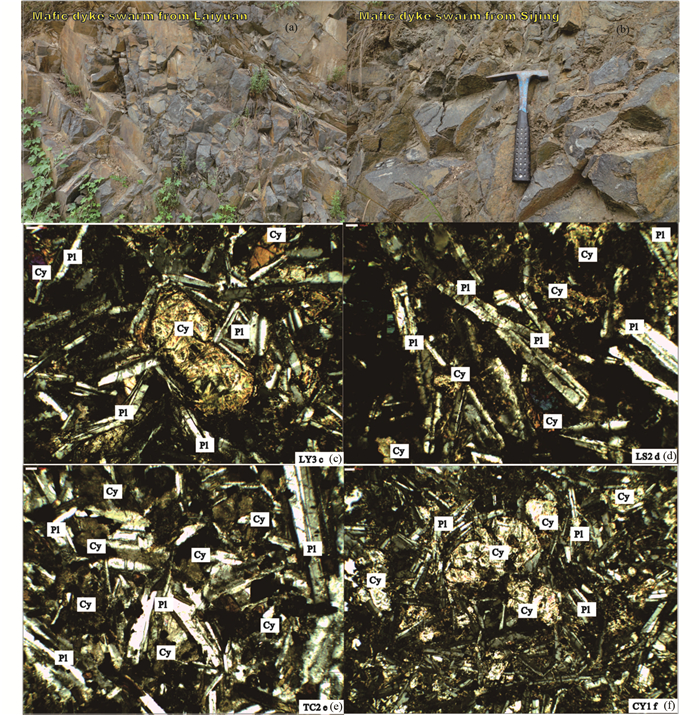
|
Figure 2 The mafic dyke swarm from Laiyuan and Sijing (a, b), and the monoclinic pyroxene plots from Laiyuan, Lingshou, Changyi, and Tancheng (c-f) |
In contrast, the NW-trending mafic dykes (Changyi, Tancheng, Sijing, Dingyuan, Hefei) (Fig. 2b, e, f) from the Tan-Lu Fault are hosted in Proterozoic granites, sedimentary rocks and granitic complexes, and Mesozoic volcanic and sedimentary rocks, are vertical, and strike NE-SW. They are 10~130m wide and 5~60km long. They contain 30%~35% micro-phenocrysts (0.5~1.3mm across) of clinopyroxene and plagioclase, along with minor biotite, within a groundmass of pyroxene, plagioclase, magnetite, and chlorite.
4 MethodsZircons from 12 mafic dyke samples from the Taihang-Da Hinggan Mountain gravity gradient belt and the Tan-Lu Fault zone of Hebei, Shanxi, Shandong, and Anhui provinces were separated using conventional heavy liquid and magnetic techniques. Representative zircons were then handpicked under a binocular microscope before being mounted in an epoxy resin disc, polished, and coated with gold prior to analysis. These zircons were imaged using transmitted and reflected light microscopy, and cathodoluminescence (CL) to highlight external and internal structures. The CL imaging and U-Pb analyses were undertaken at the State Key Laboratory of Continental Dynamics, Northwest University, Xi'an, China. The analytical procedures used are described in detail in Harris et al. (2004) and Campbell et al. (2006). U-Th-Pb ratios and absolute abundances were determined by reference to multiple measurements of a standard TEMORA zircon and a NIST 610 glass standard.
The whole-rock and Sr-Nb-Pb isotopic geochemistry of 26 mafic dyke samples was determined during this study. Prior to analysis, these samples were trimmed to remove altered surface material before being cleaned with deionized water, crushed, and powdered in an agate mill.
Major element compositions were determined using a PANalytical Axios-Advanced X-ray fluorescence (XRF) spectrometer at the State Key Laboratory of Ore Deposit Geochemistry (SKLODG), Institute of Geochemistry, Chinese Academy of Sciences, Guiyang, China, using fused lithium tetraborate glass pellets. These analyses have an analytical precision of better than 5%. Trace element compositions were determined by ICP-MS using a Perkin-Elmer ELAN DRC-e instrument at SKLODG. Prior to analysis, powdered samples (50mg) were dissolved in high-pressure Teflon bombs using a HF+HNO3 solution for 48 hours at ca. 190℃ (Qi et al., 2000). Signal drift during analysis was monitored using Rh as an internal standard, and the GBPG-1, OU-6, GSR-1, and GSR-3 standards were used for analytical quality control, indicating an analytical precision generally better than 5% for trace elements.
The Rb-Sr and Sm-Nd isotopic analyses began by spiking the sample powders with mixed isotope tracers before dissolution in Teflon capsules using a HF+HNO3 acid solution and separation using conventional cation-exchange techniques. Isotopic measurements were undertaken using thermal ionization mass spectrometry (TIMS) at the Isotopic Geochemistry Laboratory of the Yichang Institute of Geology and Minerals Resources, Yichang, China. This analysis yielded procedural blanks of < 200pg for Sm and Nd, and < 500pg for Rb and Sr. The isotopic ratios of Sr and Nd were corrected for mass fractionation by normalizing to 86Sr/88Sr=0.1194 and 146Nd/144Nd=0.7219, respectively. Analysis of the NBS987 standard yielded a mean 87Sr/86Sr value of 0.710246±16 (2σ), and analysis the La Jolla standard yielded a mean 143Nd/144Nd value of 0.511863±8 (2σ). Prior to Pb isotopic analysis, Pb was separated and purified by conventional cation-exchange techniques (i.e., micro-columns filled with AG1.8, 200~400 mesh resin) using diluted HBr as an eluent. Analysis of the NBS981 standard yielded a mean 204Pb/206Pb value of 0.0896±15, a mean 207Pb/206Pb value of 0.9145±8, and a mean 208Pb/206Pb value of 2.162±2.
5 Results5.1 Zircon U-Pb agesZircon is relatively abundant in the mafic dykes (Table 1), and all zircons show oscillatory or planar zoning in CL images (Fig. 3a-l), indicating a magmatic origin. None of the zircons show evidence of inherited cores and all have relatively high Th/U ratios (0.78~2.49), which also indicate a magmatic origin.
| Table 1 Zircon LA-ICP-MS U-Pb isotopic data for samples from dolerites in the study area of the Taihang-Da Hinggan Mountain belt and Tan-Lu Fault zone |
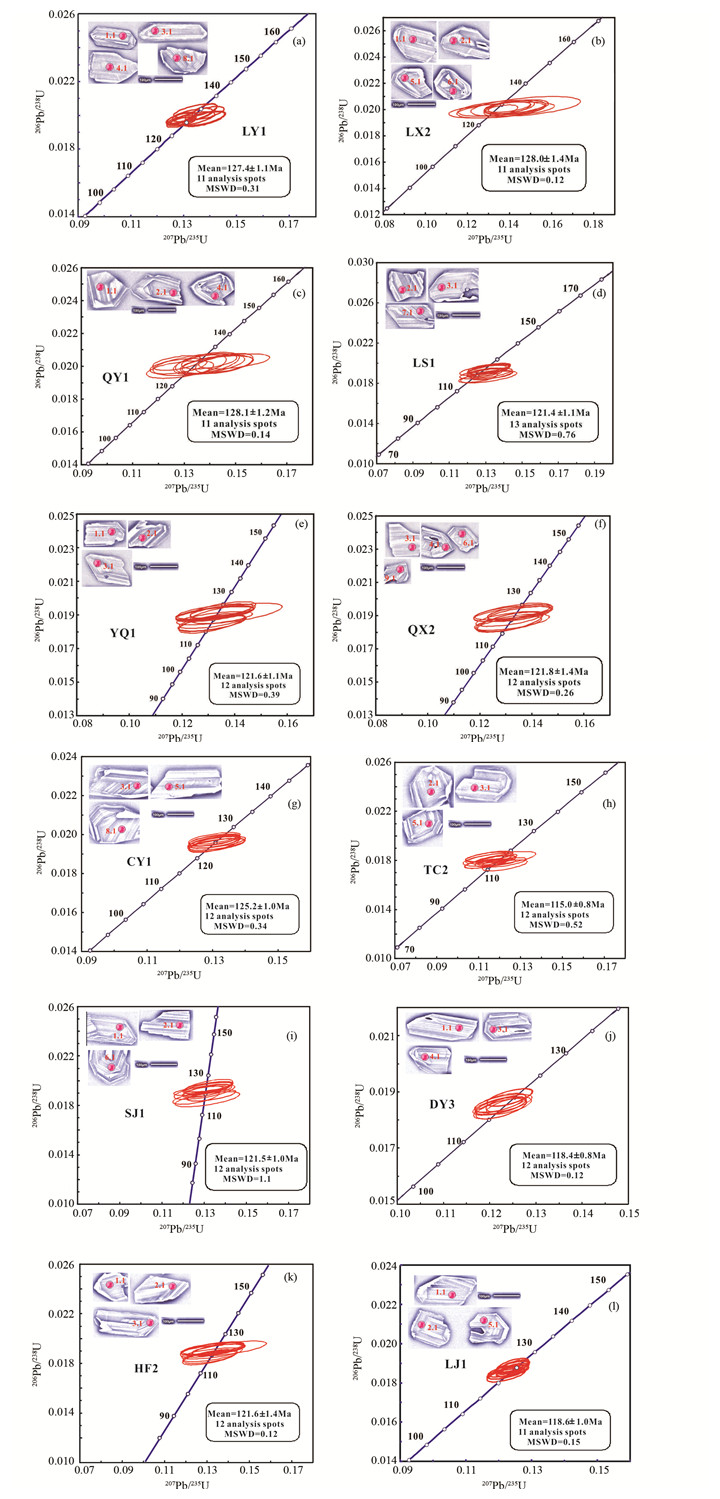
|
Figure 3 Zircon LA-ICP-MS U-Pb concordia diagrams for mafic dykes in the study area of the Taihang-Da Hinggan Mountain belt and the Tan-Lu Fault zone |
Results from 206Pb/238U age analyses of samples from dykes in the 12 counties considered in this study are presented in Table 1 and summarized here. Zircons from NE-trending mafic dykes yielded the weighted mean age between 128.1±1.2Ma and 121.4±1.1Ma (Fig. 3a-f). And the zircons from NW-trending mafic dykes yielded the weighted mean age between 125.2±1.0Ma and 115.0±0.8Ma (Fig. 3g-l).
5.2 Whole-rock geochemistryThe whole-rock compositions of the mafic dykes are presented in Tables 2 and Table 3. These dykes are characterized by only slight variations in SiO2 (51.28%~51.86%), Na2O (2.45%~3.43%), and MnO (0.13%~0.17%), but have more variable concentrations of TiO2 (0.76%~1.33%), Al2O3 (14.53%~16.36%), K2O (2.62%~3.63%), Fe2O3 (7.03%~9.63%), MgO (5.06%~7.36%), CaO (6.85%~9.12%), P2O5 (0.43%~1.24%), and Mg# values (62~70) (Table 2). All dykes plot within the alkaline and shoshonitic fields on a TAS diagram (Fig. 4).
| Table 2 Major element compositions (wt%) of dolerites within the study area of the Taihang-Da Hinggan Mountain belt and Tan-Lu Fault zone |
| Table 3 Trace element compositions (×10-6) of dolerites within the study area of the Taihang-Da Hinggan Mountain belt and Tan-Lu Fault zone |
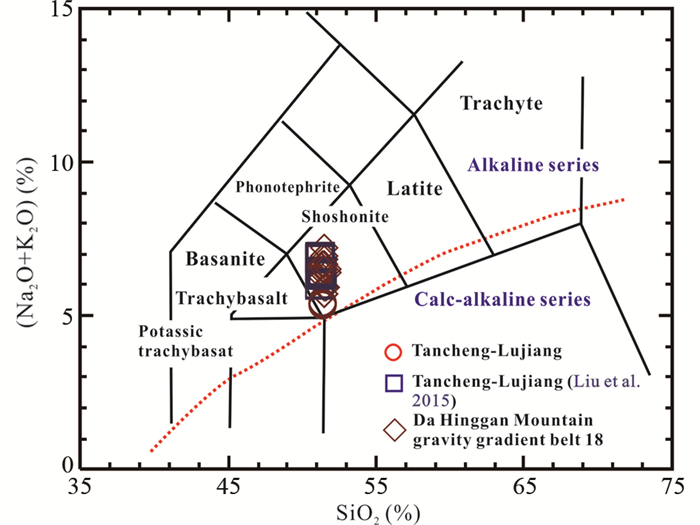
|
Figure 4 Total alkali vs. silica (TAS) plot for mafic dykes within the study area of the Taihang-Da Hinggan Mountain belt and Tan-Lu Fault zone (after Middlemost, 1994; Le Maitre, 2002) All major element data have been recalculated to 100% on an anhydrous basis |
The mafic dykes have near-identical chondrite-and primitive-mantle-normalized compositions (Table 3; Fig. 5) that are enriched in light rare earth elements (LREEs), some large ion lithophile elements (LILEs; e.g., Rb, Ba, and Sr), Pb, and Th. They also have negative Nb, Ta, and Ti anomalies, and contain generally negative Eu anomalies (Eu/Eu*=0.64~1.02). The samples have Nb/Ta ratios of 12.4~23.5 and Zr/Hf ratios of 30.3~95.3.

|
Figure 5 Chondrite-normalized REE pattern (a) and primitive-mantle-normalized multi-element variation diagram (b) of the mafic dykes in the study area of the Taihang-Da Hinggan Mountain belt and Tan-Lu Fault zone (normalization values after Sun and McDonough, 1989) |
The Sr, Nd, and Pb isotopic compositions of representative dolerite samples are presented in Tables 4 and Table 5. These dykes have a wide range of initial 87Sr/86Sr ratios (0.7056~0.7057, the Taihang-Da Hinggan Mountain gravity lineament; 0.7102~0.7105, the Tan-Lu Fault) and negative εNd(t) values (-15.5 to -12.4) (Table 4) that are indicative of a common source region. In addition, analysis of these dykes yields Nd model ages of 1.82~2.69Ga (Table 4), suggesting that these samples have EM1-like Sr-Nd isotopic ratios (Hart, 1984; Zindler and Hart, 1986), similar to other Mesozoic mafic dykes from the NCC (Liu et al., 2008a, b, 2009a, b). This is also reflected in the position of these dykes within the mantle array and shoshonitic field of an εNd(t) vs. (87Sr/86Sr)i diagram (Fig. 6).
| Table 4 Sr-Nd isotopic compositions of representative dolerites from the study area of the Taihang-Da Hinggan Mountain belt and Tan-Lu Fault zone |
| Table 5 Pb isotopic compositions of representative dolerites from the study area of the Taihang-Da Hinggan Mountain belt and Tan-Lu Fault zone |
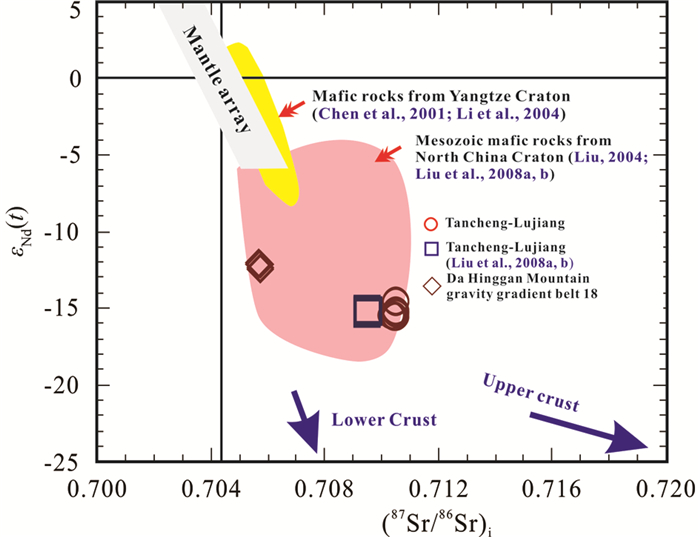
|
Figure 6 Initial 87Sr/86Sr vs. εNd(t) diagram for mafic dykes in the study area of the Taihang-Da Hinggan Mountain belt and Tan-Lu Fault zone |
Also shown are the compositions of Mesozoic mafic rocks from the NCC (Liu et al., 2008a, b, 2009a) and mafic rocks from the Yangtze Craton (Chen et al., 2001; Li et al., 2004)
The dolerites have relatively constant Pb isotopic ratios similar to other of mafic dykes of the NCC: (206Pb/204Pb)i=16.45~16.49, (207Pb/204Pb)i=15.44~15.51, and (208Pb/204Pb)i=36.49~36.53 (Zhang et al., 2004; Xie et al., 2006; Liu et al., 2008a, b, 2009a, b) (Table 5). They also show an EM1-like isotopic signature (Fig. 7b), but differ from the composition of mafic dykes from the Yangtze Craton.

|
Figure 7 208Pb/204Pb and 207Pb/204Pb vs. 206Pb/204Pb diagrams for mafic dykes from the study area of the Taihang-Da Hinggan Mountain belt and Tan-Lu Fault zone |
Also shown are I-MORB (Indian MORB) and P&N-MORB (Pacific and North Atlantic MORB), OIB, and NHRL fields after Zou et al. (2000), and a 4.55Ga geochron from Hart (1984). The NCC data are from Zhang et al. (2004) and Xie et al. (2006), and data of the Yangtze Craton mafic rocks are from Yan et al. (2003)
6 DiscussionMesozoic intrusions are widespread in the Taihang-Da Hinggan Mountain gravity lineament, and include 140~125Ma diorite-monzonite complexes (Dong et al., 2003), Late Mesozoic gabbros and intermediate-felsic rocks (Cai et al., 2003, 2004; Yang et al., 2004; Qin, 2005), magmatic rocks in the Taihang mountains (Chen et al., 2005, 2007; Ying et al., 2010), alkaline rocks, granitoid complexes, and granites (Cai et al., 2006), 125~127Ma monzonites and diorites (Wang et al., 2006), 115~135Ma diorites, 134~149Ma volcanic rocks, 135~145Ma complexes (Cai et al., 2003; Chen et al., 2003; Chen and Zhai, 2003), and ca.120Ma calc-alkaline lamprophyres (Chen et al., 2003). Mesozoic magmatism is also widespread in the area of the Tan-Lu Fault zone, including high-K calc-alkaline and volcanic rocks (Zhu et al., 2010; Li et al., 2012), monzonites and granites (Cao et al., 2010), and alkali-rich intrusive rocks. Both the magmatism in the Taihang-Da Hinggan Mountain gravity lineament and in Tan-Lu Fault zone is the result of lithospheric extension. In addition, Mesozoic mafic dykes (e.g., lamprophyre and dolerite dykes) are widespread in the Tan-Lu Fault zone, and these formed in an extensional setting. However, until now, few studies have examined the Mesozoic mafic dykes in the Taihang-Da Hinggan Mountain gravity gradient belt and the Tan-Lu Fault zone (Guo et al., 2001; Huang et al., 2012).
6.1 Mantle source and crustal contaminationThe dykes considered in this study are characterized by low SiO2 contents (50.3%~51.8%; Table 2), suggesting they were derived from an ultramafic source (Liu et al., 2008a, b, 2009a, 2013a, b, c, d). Crustal rocks can therefore be ruled out as possible sources, as partial melting of crustal rocks (Hirajima et al., 1990) and lower-crustal intermediate granulites (Gao et al., 1998) in the deep crust would produce liquids with high Si and low Mg contents (i.e., granitoid liquids; Rapp et al., 2003). In addition, the high initial 87Sr/86Sr ratios (0.7056~0.7105) and negative εNd(t) values (-15.4 to -12.4) of the mafic dykes are consistent with derivation from an enriched lithospheric mantle source, rather than an asthenospheric mantle source which would contain a depleted Sr-Nd isotopic composition, such as MORB.
Crustal contamination may cause a significant depletion in Nb-Ta and enrichment in Sr-Nd isotopic signatures in basaltic rocks (Guo et al., 2004). The mafic dykes studied here are characterized by negative Nb-Ta anomalies (Table 3; Fig. 4b), which implies a crustal component in their origin. In addition, plots of SiO2, CaO, TiO2, and P2O5 vs. MgO (not shown) show only a weak linear correlation, suggesting magma mixing or contamination played an important role during magma ascent. This inference is also supported by relatively low Ni (6.65×10-6~225×10-6), low Ta/La ratios (0.01~0.02 cf. Ta/La=0.06 for primitive mantle; Wood et al., 1979), lack of correlations between Mg#, Ni, and the initial Sr ratio (not shown), depletion in high field strength elements (Nb, Ta, and Ti), positive Pb anomalies (Fig. 5b; Zhang et al., 2005), and high Ba/Nb ratios (140~438; Table 3; Jahn et al., 1999). However, these dykes lack classical signatures of crustal assimilation including variations in Sr-Nd isotopes, a positive correlation between MgO and εNd(t) values, and a negative correlation between MgO and (87Sr/86Sr)i ratios. These observations suggest that the mafic dykes have not, in fact, been significantly affected by crustal contamination.
6.2 Genetic modelAll the dykes examined in this study are distributed along a partial melting trend line on a plot of La vs. La/Sm (not shown). This result, combined with their Sr-Nd-Pb isotopic compositions (Tables 4, Table 5), indicates the dykes were derived from partial melting of an EM1-like mantle source (Fig. 6, Fig. 7). This view is also supported by their relatively high Ti/Y ratios (213~477; Johnson, 1998). Plots of La/Sm vs. La and Sm/Yb vs. Sm (Fig. 8a, b) indicate that the dykes were derived from 1.0%~5.0% partial melting of a garnet-lherzolite mantle source. In addition, the distinctive negative Nb, Ta, and Ti anomalies on a primitive-mantle-normalized trace element diagram (Fig. 4b) indicate the involvement of components from the Proto-Tethys oceanic or ancient continental crust (Zhang et al., 2005). There are positive correlations between MgO and Fe2O3, and CaO, CaO/Al2O3, and Ni, and negative correlations in plots of MgO vs. Al2O3 and Sr (not shown), suggesting the fractionation of olivine, clinopyroxene, hornblende, and plagioclase. This inference is also supported by the correlations between Sr and each of Ba and Rb. In addition, the high La/Nb ratios (3.6~9.7) in these rocks (Table 3) differ from those of most intra-plate volcanic rocks, including OIB, alkali basalt, and kimberlite (typically 0.5~2.5; Jahn et al., 1999). These data suggest that continental materials (granitoids, granulites, sediments, etc.) were involved in the origin of the mantle-derived magma's, which is supported by the low εNd(t) values (-15.4 to -12.4) and high initial 87Sr/86Sr values (0.7056~0.7105). Therefore, we propose the involvement of crustal components already incorporated into the mantle source. However, it is important to identify the mechanism by which these crustal materials were incorporated.
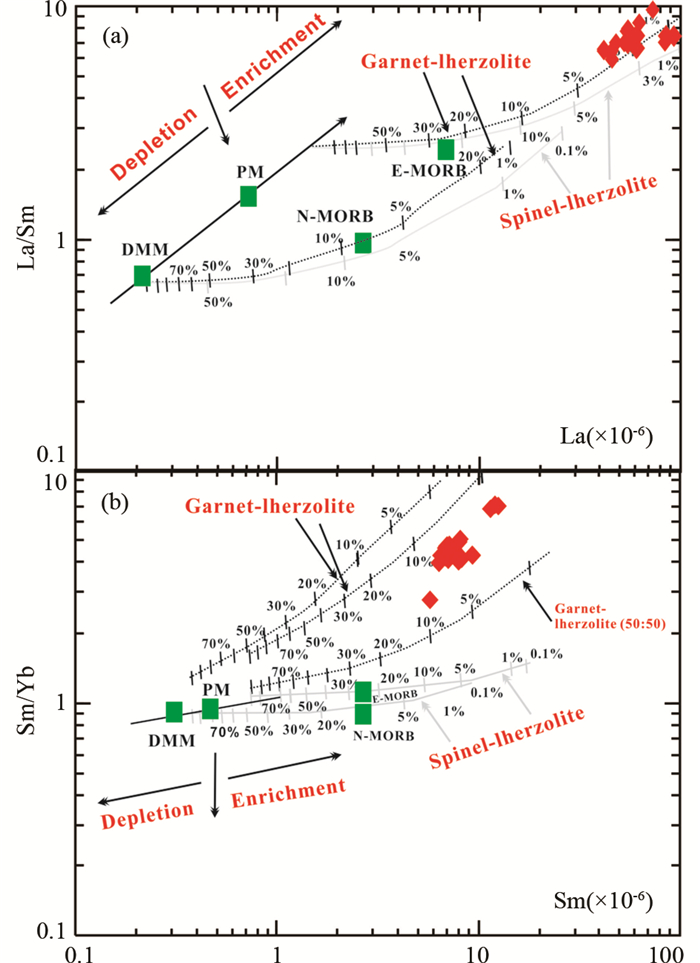
|
Figure 8 Variations in La/Sm vs. La (a) and Sm/Yb vs. Sm (b) compositions of samples analyzed during this study, and melt curves and lines derived from the non-modal batch melting equations of Shaw (1970) Melt curves are shown for spinel lherzolite (with mode and melt mode compositions of ol0.600+opx0.200+cpx0.100+gt0.100 and ol0.030+opx0.160+cpx0.880+sp0.110, respectively; Walter, 1998). Mineral/matrix partition coefficients and the composition of the DMM are from McKenzie and O'Nions(1991, 1995). Primitive mantle, and N-MORB and E-MORB compositions are from Sun and McDonough (1989). Tick marks on each curve or line correspond to changing degrees of partial melting of a given mantle source |
Previous research has suggested the destruction of the NCC lithosphere was controlled by a number of factors, such as collision between the Yangtze Craton and the NCC, subduction of the Paleo-Pacific Plate and closure of the overlying ocean, India-Eurasia collision, and a mantle plume (Gao et al., 2004). However, as described above, these factors are still debated, meaning that the origin of the Mesozoic igneous rocks remains a topic of controversy. Here we provide a discussion on key aspects of the various models that describe the origin of the Mesozoic igneous rocks.
It is generally believed that the final collision between the NCC and the Yangtze Block occurred during the Triassic (Zhang et al., 2005). Additionally, the studied mafic dykes have Pb isotopic characteristics that are distinct from those of the Yangtze Craton lithosphere mantle (Fig. 7a, b), which rules out the involvement of this mantle in their origin (Xie et al., 2006; Liu et al., 2009a). In contrast, the distinctive Pb isotopic data suggest that the dykes were derived from the overlying NCC during the Late Mesozoic (Xie et al., 2006).
During subduction, the Paleo-Pacific Plate most likely released melt and/or fluids during its descent into the mantle, and the melt/fluids from the subduction of the Pacific Plate (i.e., the Izanagi Plate) metasomatized and modified the lithospheric mantle beneath the NCC. However, during the Late Mesozoic, the Izanagi Plate primarily moved towards the N or the NNE (Maruyama and Send, 1986; Kimura et al., 1990), and there was no westward subduction of an ancient Pacific Plate below the NCC prior to the Early Cretaceous, meaning that this plate had little influence on the origin of the dykes considered in this study. Moreover, a recent U-Th disequilibrium study of Cenozoic potassium basalt from northeastern China also argue against contributions from the Paleo-Pacific Plate (Zou et al., 2003). Research into early Cretaceous mantle-derived rocks from the western NCC also indicates that the origin of the enriched lithospheric mantle sources for the Late Mesozoic rocks was unrelated to subduction of the Paleo-Pacific Plate (Wang et al., 2006; Ying et al., 2007). Additionally, subduction of the Paleo-Pacific Plate cannot explain the ubiquitous compositional grading of the Mesozoic igneous rocks in eastern China. If the adjacent ocean (e.g., the Asia or Tethys Ocean) was subducted, the destruction of the NCC should have been complete; however, this did not occur.
The presence of a mantle plume is one of the least discussed mechanisms that may explain the destruction of the NCC. There are three similar models: 1) upwelling of asthenosphere and destruction of the NCC occurred as a result of a mantle plume (Xu, 2007); 2) giant mantle plumes (e.g., Ontong Java) ascended in the SW Pacific Ocean, which finally resulted in destruction of the NCC (Zhao et al., 2004); and 3) fracturing of the Gondwana mainland and destruction of the NCC occurred due to the activity of mantle plumes in the Late Mesozoic (Wilde et al., 2003). However, based on the petrologic, geochemical, and geophysical evidence, there have been no mantle plumes in the NCC since the Paleozoic. Therefore, none of the above mantle plume models can explain the origin of the mafic dykes.
In general, it is accepted that lithospheric mantle beneath NCC was progressively enriched due to successive hybridization of foundered lower crust (Liu et al., 2008a, b, 2009a). Eclogite can be recycled into the mantle (Arndt and Goldstein, 1989; Kay and Mahlburg-Kay, 1991; Jull and Kelemen, 2001; Gao et al., 2004), primarily as eclogite has a higher density (0.2~0.4g·cm-3) than lithospheric mantle peridotite (Rudnick and Fountain, 1995; Jull and Kelemen, 2001; Anderson, 2006; Levander et al., 2006). Eclogites also have lower melting temperatures than mantle peridotites (Yaxley, 2000; Kogiso et al., 2003; Sobolev et al., 2005), indicating that foundered silica-saturated eclogites can melt to produce silicic tonalite to trondhjemite melts that may variably hybridize with overlying mantle peridotite material. These reactions can produce an olivine-free pyroxenite that, if subsequently melted, generates basaltic melts (Kogiso et al., 2003; Sobolev et al., 2005). The foundering model is supported by the voluminous coeval magmatism that is well documented in the Taihang-Da Hinggan and Tan-Lu tectonic belts (Deng et al., 1996, 2000; Zhu et al., 2010; Cai et al., 2003, 2004, 2006; Chen et al., 2003, 2005, 2006, 2007; Liu et al., 2004, 2005, 2006, 2008a, b, c, 2009a, b), as well as the large-scale mineralization and adakitic lavas (Xiong et al., 2011; Gu et al., 2013) in this region.
We therefore propose a model in which lower crustal delamination coincided with mafic magmatism. The Triassic collision (240~185Ma; Zhang et al., 2005; Liu et al., 2008a, b, 2009a) between the Yangtze Craton and the NCC generated thickened crust, causing the eclogitization of its lower parts (Liu et al., 2008a, b, 2009a). Foundering of this eclogite at ca. 185~165Ma beneath the Taihang-Da Hinggan orogenic belt and the eastern NCC (Liu et al., 2008a, b, 2009a), combined with ongoing subduction of the Paleo-Pacific Plate (Chen et al., 2005), triggered asthenospheric upwelling, orogenic collapse, and lithospheric extension and thinning in the study area. The silicic melts generated by the melting of the foundered eclogites reacted extensively with the overlying mantle peridotite, with the subsequent (128~115Ma) decompression melting of this hybridized lithospheric mantle producing primary basaltic melts that fractionated to produce the mafic dyke swarms of the Taihang-Da Hinggan Mountain belt and Tan-Lu Fault zone.
7 ConclusionsNew geochronological, geochemical, and Sr-Nd-Pb isotopic data for the mafic dykes of the northern Taihang-Da Hinggan Mountain belt and Tan-Lu Fault zone allow us to reach the following conclusions.
(1) The mafic dykes were intruded during the Early Cretaceous, as indicated by 12 new zircon U-Pb ages of that range between 128.1±1.2Ma and 115.0±0.8Ma.
(2) All of the dykes are dolerites and have doleritic textures. They are all alkaline and shoshonitic, are enriched in the LREE, some LILE (e.g., Rb, Ba, and Sr), Pb, and Th, and are depleted in Nb, Ta, and Ti. They have high initial 87Sr/86Sr ratios (0.7056~0.7105), negative εNd(t) values (-15.4 to -12.4), relatively constant initial Pb isotopic ratios (16.45~16.49, 15.44~15.51, and 36.49~36.53 for 206Pb/204Pb, 207Pb/204Pb, and 208Pb/204Pb, respectively), and relatively old Nd model ages (1.82~2.69Ga). These data suggest that the magma that formed these dykes were generated by a certain extent partial melting (1.0%~5.0%) of EM1-like garnet-lherzolite mantle material. The magmas fractionated olivine, clinopyroxene, and hornblende during ascent while undergoing negligible crustal contamination.
(3) The 128~115Ma mafic dyke swarms of the Taihang-Da Hinggan Mountain belt and Tan-Lu Fault zone formed as a result of asthenospheric upwelling associated with foundering of eclogite from lower thickened crust in a tectonic setting influenced by ongoing collision of the Paleo-Pacific Plate.
Acknowledgments The authors thank Dr. Shuqin Yang for assistance during XRF analyses, Prof. Liang Qi for assistance during ICP-MS analyses, and Profs. Xiaoming Liu and Honglin Yuan for assistance during LA-ICP-MS U-Pb dating. This study was supported by the National Natural Science Foundation of China (grants 41373028 and 41573022).| Anderson DL. 2006. Speculations on the nature and cause of mantle heterogeneity. Tectonophysics, 146(1-4): 7–22. |
| Arndt NT, Goldstein SL. 1989. An open boundary between lower continental crust and mantle: Its role in crust formation and crustal recycling. Tectonophysics, 161(3-4): 201–212. DOI:10.1016/0040-1951(89)90154-6 |
| Cai JH, Yan GH, Chang ZS, Wang XF, Shao HX, Chu ZY. 2003. Petrological and geochemical characteristics of the Wanganzhen complex and discussion on its genesis. Acta Petrologica Sinica, 19(1): 81–92. |
| Cai JH, Yan GH, Xiao CD, Wang GY, Mu BL, Zhang RH. 2004. Nd, Sr, Pb isotopic characteristics of the Mesozoic intrusive rocks in the Taihang-Da Hinggan Mountains Tectonomagmatic Belt and their source region. Acta Petrologica Sinica, 20(5): 1225–1242. |
| Cai JH, Yan GH, Xu BL, Wang GY, Mu BL, Zhao YC. 2006. The Late Mesozoic alkaline intrusive rocks at the east foot of the Taihang-Da Hinggan Mountains: Lithogeochemical characteristics and their implications. Acta Geoscientia Sinica, 27(5): 447–459. |
| Campbell IH, Ballard JR, Palin JM, Allen C, Faunes A. 2006. U-Pb zircon geochronology of granitic rocks from the Chuquicamata-El Abra porphyry copper belt of northern Chile: Excimer laser ablation ICP-MS analysis. Economic Geology, 101(7): 1327–1344. DOI:10.2113/gsecongeo.101.7.1327 |
| Cao GY, Xue HM, Wang JG. 2014. Zircon U-Pb age and geochemistry of Mesozoic intermediate and acidic volcanic rocks from the Shandong segment (Jiaodong area) of the Tan-Lu fault. Acta Petrologica et Mineralogica, 33(6): 1019–1038. |
| Cao Y. 2009. Geochemistry characteristics and its geological significance of the Late Mesozoic volcanic rocks from the Shandong segment of the Tan-Lu fault zone. Master Degree Thesis. Hefei: Hefei University of Technology, 1-55 (in Chinese) |
| Cao Y, Niu ML, Xie CL, Xie WY, Wang JX. 2010. Discussion of petrogenesis on Late Mesozoic intrusions from the northern segment of Zhangbaling uplift belt along the Tan-Lu Fault. Journal of Hefei University of Technology, 33(3): 415–420. |
| Carlson RW, Pearson DG, James DE. 2005. Physical, chemical, and chronological characteristics of continental mantle. Reviews of Geophysics, 43(1): RG1001. |
| Chen B, Zhai M. 2003. Geochemistry of Late Mesozoic lamprophyre dykes from the Taihang Mountains, North China, and implications for the sub-continental lithospheric mantle. Geological Magazine, 140(1): 87–93. DOI:10.1017/S0016756802007124 |
| Chen B, Zhai MG, Shao JA. 2003. Petrogenesis and significance of the Mesozoic North Taihang complex: Major and trace element evidence. Science in China (Series D), 46(9): 941–953. DOI:10.1007/BF02991340 |
| Chen B, Tian W, Zhai MG, Arakawa Y. 2005. Zircon U-Pb geochronology and geochemistry of the Mesozoic magmatism in the Taihang Mountains and other places of the North China craton, with implications for petrogenesis and geodynamic setting. Acta Petrologica Sinica, 21(1): 13–24. |
| Chen B, Liu CQ, Tian W. 2006a. Magma-mixing between mantle-and crustal-derived melts in the process of Mesozoic magmatism, Taihangshan: Constraints from petrology and geochemistry. Earth Science Frontiers, 13(2): 140–147. |
| Chen JF, Yan J, Xie Z, Xu X, Xing F. 2001. Nd and Sr isotopic compositions of igneous rocks from the Lower Yangtze region in eastern China: Constraints on sources. Phys. Chem. Earth A, 26(9-10): 719–731. DOI:10.1016/S1464-1895(01)00122-3 |
| Chen L, Zheng TY, Xu WW. 2006b. A thinned lithospheric image of the Tanlu Fault zone, eastern China: Constructed from wave equation based receiver function migration. J. Geophys. Res., 111(B9). DOI:10.1029/2005JB003974 |
| Chen ZC, Chen B, Tian W. 2007. Zircon U-Pb ages, Hf isotopic compositions and geological significance: A case study of Mesozoic batholiths and mafic enclaves in North Taihang. Acta Petrologica Sinica, 23(2): 295–306. |
| Deng JF, Zhao HL, Mo XX, Luo ZX, Luo ZH. 1996. Continental Roots-plume Tectonics of China: Key to the Continental Dynamics. Beijing: Geological Publishing House. |
| Deng JF, Zhao GC, Zhao HL, Luo ZH, Dai SQ, Li KM. 2000. Yanshanian igneous petrotectonic assemblage and orogenic-deep processes in east China. Geological Review, 46(1): 41–48. |
| Dong JH, Chen B, Zhou L. 2003. Genesis of Fushan intrusive in southern Taihang Mountains: The evidences from petrology and geochemistry. Progress in Natural Science, 13(7): 767–774. |
| Fan WM, Guo F, Wang YJ, Zhang M. 2004. Late Mesozoic volcanism in the northern Huaiyang tectono-magmatic belt, central China: Partial melts from a lithospheric mantle with subducted continental crust relicts beneath the Dabie Orogen?. Chemical Geology, 1209(1-2): 27–48. |
| Fu PY. 2013. Geochronology and petrogenesis of the Early Cretaceous volcanic rocks in the Yi-Shu fault zone. Master Degree Thesis. Hefei: Hefei University of Technology, 1-39 (in Chinese) |
| Gao S, Zhang BR, Luo TC, Li ZJ, Xie QL, Gu XM, Zhang HF, Ouyang JP, Wang DP, Gao QL. 1992. Chemical composition of the continental crust in the Qinling Orogenic Belt and its adjacent North China and Yangtze cratons. Geochimica et Cosmochimica Acta, 56(11): 3933–3950. DOI:10.1016/0016-7037(92)90007-6 |
| Gu HO, Xiao YL, Santosh M, Li WY, Yang XY, Pack A, Hou ZH. 2013. Spatial and temporal distribution of Mesozoic adakitic rocks along the Tan-Lu Fault, eastern China: Constraints on the initiation of lithospheric thinning. Lithos, 177: 352–365. DOI:10.1016/j.lithos.2013.07.011 |
| Guo F, Fan WM, Wang YJ, Zhang M. 2004. Origin of Early Cretaceous calc-alkaline lamprophyres from the Sulu orogen in eastern China: Implications for enrichment processes beneath continental collisional belt. Lithos, 78(3): 291–305. DOI:10.1016/j.lithos.2004.05.001 |
| Harris AC, Allen CM, Bryan SE, Compbell IH, Holcombe RJ, Palin JM. 2004. ELA-ICP-MS U-Pb zircon geochronology of regional volcanism hosting the Bajo de la Alumbrera Cu-Au deposits: Implications for porphyry-related mineralization. Mineralium Deposita, 39(1): 46–67. DOI:10.1007/s00126-003-0381-0 |
| Hart SR. 1984. A large-scale isotope anomaly in the southern Hemisphere mantle. Nature, 309(5971): 753–757. DOI:10.1038/309753a0 |
| Hirajima T, Ishiwatari A, Cong B, Zhang R, Banno S, Nozaka T. 1990. Coesite from Mengzhong eclogite at Donghai County, northeastern Jiangsu Province, China. Mineralogical Magazine, 54(377): 579–583. DOI:10.1180/minmag |
| Hong DW, Wang T, Tong Y, Wang XX. 2003. Mesozoic granitoids from north China block and Qinling-Dabie-Sulu orogenic belt and their deep dynamic process. Earth Science Frontiers, 10(3): 231–256. |
| Huang XL, Zhong JW, Xu YG. 2012. Two tales of the continental lithospheric mantle prior to the destruction of the North China Craton: Insights from Early Cretaceous mafic intrusions in western Shandong, East China. Geochimica et Cosmochimica Acta, 96: 193–214. DOI:10.1016/j.gca.2012.08.014 |
| Jahn BM, Wu FY, Lo CH, Tsai CH. 1999. Crust-mantle interaction induced by deep subduction of the continental crust: Geochemical and Sr-Nd isotopic evidence from post-collisional mafic-ultramafic intrusions of the northern Dabie complex, central China. Chemical Geology, 157(1-2): 119–146. DOI:10.1016/S0009-2541(98)00197-1 |
| Johnson KTM. 1998. Experimental determination of partition coefficients for rare earth and high-field-strength elements between clinopyroxene, garnet, and basaltic melt at high pressures. Contributions to Mineralogy and Petrology, 133(1-2): 60–68. DOI:10.1007/s004100050437 |
| Jull M, Kelemen PB. 2001. On the conditions for lower crustal convective instability. J. Geophys. Res., 106(B4): 6423–6446. DOI:10.1029/2000JB900357 |
| Kay RW, Mahlburg-Kay SM. 1991. Creation and destruction of lower continental crust. Geologische Rundschau, 80(2): 259–278. DOI:10.1007/BF01829365 |
| Kimura G, Takahashi M, Kono M. 1990. Mesozoic collision-extrusion tectonics in eastern Asia. Tectonophysics, 181(1-4): 15–23. DOI:10.1016/0040-1951(90)90005-S |
| King SD. 2005. Archean cratons and mantle dynamics. Earth and Planetary Science Letters, 234(1-2): 1–14. DOI:10.1016/j.epsl.2005.03.007 |
| Kogiso T, Hirschmann MM, Frost DJ. 2003. High-pressure partial melting of garnet pyroxenite: Possible mafic lithologies in the source of ocean island basalts. Earth and Planetary Science Letters, 216(4): 603–617. DOI:10.1016/S0012-821X(03)00538-7 |
| Le Maitre RW. 2002. Igneous Rocks: A Classification and Glossary of Terms. 2nd Edition. Cambridge: Cambridge University Press: 1-236. |
| Levander A, Niu FL, Lee CTA, Cheng X. 2006. Imag(in)ing the continental lithosphere. Tectonophysics, 416(1-4): 167–185. DOI:10.1016/j.tecto.2005.11.018 |
| Li CW, Guo F, Li XY. 2004. Petrogenesis and geodynamic implications of Late Mesozoic mafic volcanic rocks from the Lishui Basin of the Lower Yangtze region. Geochimica, 33(4): 361–371. |
| Li H, Ling MX, Li CY, Zhang H, Ding X, Yang XY, Fan WM, Li YL, Sun WD. 2012. A-type granite belts of two chemical subgroups in central eastern China: Indication of ridge subduction. Lithos, 150: 26–36. DOI:10.1016/j.lithos.2011.09.021 |
| Li SR, Santosh M, Zhang HF, Shen JF, Dong GC, Wang JZ, Zhang JQ. 2013. Inhomogeneous lithospheric thinning in the central North China Craton: Zircon U-Pb and S-He-Ar isotopic record from magmatism and metallogeny in the Taihang Mountains. Gondwana Research, 23(1): 141–160. DOI:10.1016/j.gr.2012.02.006 |
| Liu DY, Nutman AP, Compston W, Wu JS, Shen QH. 1992. Remnants of ≥3800Ma crust in the Chinese part of the Sino-Korean craton. Geology, 20(4): 339–342. DOI:10.1130/0091-7613(1992)020<0339:ROMCIT>2.3.CO;2 |
| Liu S, Hu RZ, Zhao JH, Feng CX. 2004. K-Ar geochronology of Mesozoic mafic dikes in Shandong Province, eastern China: Implications for crustal extension. Acta Geologica Sinica, 78(6): 1207–1213. DOI:10.1111/acgs.2004.78.issue-6 |
| Liu S, Zou HB, Hu RZ, Zhao JH, Feng CX. 2006. Mesozoic mafic dikes from the Shandong Peninsula, North China Craton: Petrogenesis, tectonic implications. Geochemical Journal, 40(2): 181–195. DOI:10.2343/geochemj.40.181 |
| Liu S, Hu RZ, Gao S, Feng CX, Qi L, Zhong H, Xiao TF, Qi YQ, Wang T , Coulson IM. 2008a. Zircon U-Pb geochronology and major, trace elemental and Sr-Nd-Pb isotopic geochemistry of mafic dykes in western Shandong Province, east China: Constrains on their petrogenesis and geodynamic significance. Chemical Geology, 255(3-4): 329–345. DOI:10.1016/j.chemgeo.2008.07.006 |
| Liu S, Hu RZ, Gao S, Feng CX, Qi YQ, Wang T, Feng GY, Coulson IM. 2008b. U-Pb zircon age, geochemical and Sr-Nd-Pb-Hf isotopic constraints on age and origin of alkaline intrusions and associated mafic dikes from Sulu orogenic belt, eastern China. Lithos, 106(3-4): 365–379. DOI:10.1016/j.lithos.2008.09.004 |
| Liu S, Hu RZ, Gao S, Feng CX, Zhong H, Qi YQ, Wang T, Qi L, Feng GY. 2008c. K-Ar ages and geochemical+Sr-Nd isotopic compositions of adakitic volcanic rocks, western Shandong Province, Eastern China: Foundering of the lower continental crust. International Geology Review, 50(8): 763–779. DOI:10.2747/0020-6814.50.8.763 |
| Liu S, Hu RZ, Gao S, Feng CX, Yu BB, Feng GY, Qi YQ, Wang T, Coulson IM. 2009a. Petrogenesis of Late Mesozoic mafic dykes in the Jiaodong Peninsula, eastern North China Craton and implications for the foundering of lower crust. Lithos, 113(3-4): 621–639. DOI:10.1016/j.lithos.2009.06.035 |
| Liu S, Hu RZ, Gao S, Feng CX, Yu BB, Qi YQ, Wang T, Feng GY, Coulson IM. 2009b. Zircon U-Pb age, geochemistry and Sr-Nd-Pb isotopic compositions of adakitic volcanic rocks from Jiaodong, Shandong Province, eastern China: Constraints on petrogenesis and implications. Journal of Asian Earth Sciences, 35(5): 445–458. DOI:10.1016/j.jseaes.2009.02.008 |
| Liu S, Hu RZ, Gao S, Feng CX, Coulson IM, Feng GY, Qi YQ, Yang YH, Yang CG, Tang L. 2013a. Zircon U-Pb age and Sr-Nd-Hf isotopic constraints on the age and origin of Triassic mafic dikes, Dalian area, Northeast China. International Geology Review, 55(2): 249–262. DOI:10.1080/00206814.2012.707003 |
| Liu S, Feng CX, Jahn BM, Hu RZ, Gao S, Coulson IM, Feng GY, Lai SC, Yang CG, Yang YH. 2013b. Zircon U-Pb age, geochemical, and Sr-Nd-Hf isotopic constraints on the origin of mafic dykes in the Shaanxi Province, North China Craton, China. Lithos, 175-176(244): 254. |
| Liu S, Feng CX, Jahn BM, Hu RZ, Gao S, Feng GY, Lai SC, Yang YH, Qi YQ, Coulson IM. 2013c. Geochemical, Sr-Nd isotopic, and zircon U-Pb geochronological constraints on the petrogenesis of Late Paleoproterozoic mafic dykes within the northern North China Craton, Shanxi Province, China. Precambrian Research, 236: 182–192. DOI:10.1016/j.precamres.2013.07.007 |
| Liu S, Feng CX, Jahn BM, Hu RZ, Gao S, Coulson IM, Feng GY, Lai SC, Yang YH, Tang L. 2013d. Geochemical, Sr-Nd-Pb isotope, and zircon U-Pb geochronological constraints on the origin of Early Permian mafic dikes, northern North China Craton. International Geology Review, 55(13): 1626–1640. DOI:10.1080/00206814.2013.788242 |
| Liu YS, Gao S, Lee CTA, Hu SH, Liu XM, Yuan HL. 2005. Melt-peridotite interactions: Links between garnet pyroxenite and high-Mg# signature of continental crust. Earth and Planetary Science Letters, 234(1-2): 39–57. DOI:10.1016/j.epsl.2005.02.034 |
| Ma GX. 1997. Geological characteristics, metallogenic model of copper deposit at Muji Village of Laiyuan County, Hebei Province. J. Geol. Min. Res. North China, 12(1): 52–66. |
| Maruyama S, Send T. 1986. Orogeny and relative plate motions: Example of the Japanese Islands. Tectonophysics, 127(3-4): 305–329. DOI:10.1016/0040-1951(86)90067-3 |
| McKenzie D, O'Nions RK. 1991. Partial melt distributions from inversion of rare earth element concentrations. J. Petrol., 32(5): 1021–1091. DOI:10.1093/petrology/32.5.1021 |
| McKenzie D, O'Nions RK. 1995. The source regions of ocean island basalts. J. Petrol., 36: 133–159. DOI:10.1093/petrology/36.1.133 |
| Meng QR. 2003. What drove Late Mesozoic extension of the northern China-Mongolia tract. Tectonophysics, 369(3-4): 155–174. DOI:10.1016/S0040-1951(03)00195-1 |
| Middlemost EAK. 1994. Naming materials in the magma/igneous rock system. Earth-Sci. Rev., 37(3-4): 215–224. DOI:10.1016/0012-8252(94)90029-9 |
| Niu ML, Xie CL, Song CZ, Wang DX, Xiang BW. 2007. K-Ar dating of Early Cretaceous volcanic rocks along the Tan-Lu fault zone and its tectonic significance. Chinese Journal of Geology, 42(2): 382–387. |
| Qi L, Hu J, Gregoire DC. 2000. Determination of trace elements in granites by inductively coupled plasma mass spectrometry. Talanta, 51(3): 507–513. DOI:10.1016/S0039-9140(99)00318-5 |
| Qin XF. 2005. The feature and origin of the granite in northern Taihang Mountain. Master Degree Thesis. Lanzhou: Lanzhou University (in Chinese with English summary) |
| Rapp RP, Shimizu N, Norman MD. 2003. Growth of early continental crust by partial melting of eclogite. Nature, 425(6958): 605–609. DOI:10.1038/nature02031 |
| Rudnick RL, Fountain DM. 1995. Nature and composition of the continental crust: A lower crustal perspective. Reviews of Geophysics, 33(3): 267–309. DOI:10.1029/95RG01302 |
| Rudnick RL, Gao S, Ling WL, Liu YS , McDonough WF. 2004. Petrology and geochemistry of spinel peridotite xenoliths from Hannuoba and Qixia, North China craton. Lithos, 77(1-4): 609–637. DOI:10.1016/j.lithos.2004.03.033 |
| Shaw DM. 1970. Trace element fractionation during anataxis. Geochimica et Cosmochimica Acta, 34(2): 237–243. DOI:10.1016/0016-7037(70)90009-8 |
| Sleep NH. 2003. Survival of Archean cratonal lithosphere. J. Geophys. Res., 108(B6). DOI:10.1029/2002JB001859 |
| Sleep NH. 2005. Evolution of the continental lithosphere. Ann. Rev. Earth Planet. Sci., 33(1): 369–393. DOI:10.1146/annurev.earth.33.092203.122643 |
| Sobolev AV, Hofmann AW, Sobolev SV, Nikogosian IK. 2005. An olivine-free mantle source of Hawaiian shield basalts. Nature, 434(7033): 590–597. DOI:10.1038/nature03411 |
| Su SG, Zhou XR, Gu DL. 1999. Characteristics and evolution of Mesozoic volcanic rocks in the middle part of Tancheng-Lujiang fault belt, Yishui area, Shandong province. Geological Review, 45(7): 565–571. |
| Sun SS and McDonough WF. 1989. Chemical and isotopic systematics of oceanic basalts: Implications for mantle composition and processes. In: Saunders AD and Norry MJ (eds.). Magmatism in the Ocean Basins. Geological Society, London, Special Publication, 42(1): 313-345 |
| Tang JF, Liu YL, Wang QF. 2008. Geochronology of Mesozoic volcanic rocks in Shandong Province. Acta Petrologica Sinica, 24(6): 1333–1338. |
| Hilst RVD, McDonough B. 1999. Composition, deep structure and evolution of continents. Developments in Geotectonics, 48(1-4): Ⅸ–Ⅻ. |
| Wang YJ, Fan WM, Zhang HF, Peng TP. 2006. Early Cretaceous gabbroic rocks from the Taihang Mountains: Implications for a paleosubduction-related lithospheric mantle beneath the central North China craton. Lithos, 86(3-4): 281–302. DOI:10.1016/j.lithos.2005.07.001 |
| Wilde SA, Zhou XH, Nemchin AA, Sun M. 2003. Mesozoic crust-mantle interaction beneath the North China craton: A consequence of the dispersal of Gondwanaland and accretion of Asia. Geology, 31(9): 817–820. DOI:10.1130/G19489.1 |
| Wu Q, Niu ML, Zhu G, Xiang BW, Fu PY, Xia WJ. 2013. Petrogenesis of Early Cretaceous intermediate-feslic volcanic rocks in the Juxian area from the Tan-Lu fault zone and their tectonic implications. Acta Geologica Sinca, 87(7): 979–993. |
| Xie CL, Zhu G, Niu ML, Wang YS. 2007. LA-ICP MS zircon U-Pb ages of the Mesozoic volcanic rocks from Chuzhou area and their tectonic significances. Geological Review, 53(5): 642–655. |
| Xie Z, Li QZ, Gao TS. 2006. Comment on "Petrogenesis of post-orogenic syenites in the Sulu orogenic belt, East China: Geochronological, Geochemical and Nd-Sr isotopic evidence" by Yang et al. Chemical Geology, 235(1-2): 191–194. DOI:10.1016/j.chemgeo.2006.05.012 |
| Xiong XL, Liu XC, Zhu ZM, Li Y, Xiao WS, Song MS, Zhang S, Wu JH. 2011. Adakitic rocks and destruction of the North China Craton: Evidence from experimental petrology and geochemistry. Science China Earth Sciences, 54(6): 858–870. DOI:10.1007/s11430-010-4167-9 |
| Xu YG. 2007. Diachronous lithospheric thinning of the North China Craton and formation of the Daxin'anling-Taihangshan gravity lineament. Lithos, 96(1-2): 281–298. DOI:10.1016/j.lithos.2006.09.013 |
| Yan J, Chen JF, Yu G, Qian H, Zhou TX. 2003. Pb isotopic characteristics of Late Mesozoic mafic rocks from the Lower Yangtze region: Evidence for enriched mantle. Geological Journal of China Universities, 9(2): 195–206. |
| Yang JH, Chung SL, Zhai MG, Zhou XH. 2004. Geochemical and Sr-Nd-Pb isotopic compositions of mafic dikes from the Jiaodong Peninsula, China: Evidence for vein-plus-peridotite melting in the lithospheric mantle. Lithos, 73(3-4): 145–160. DOI:10.1016/j.lithos.2003.12.003 |
| Yang W, Li SG. 2008. Geochronology and geochemistry of the Mesozoic volcanic rocks in western Liaoning: Implications for lithospheric thinning of the North China Craton. Lithos, 102(1-2): 88–117. DOI:10.1016/j.lithos.2007.09.018 |
| Yaxley GM. 2000. Experimental study of the phase and melting relations of homogeneous basalt+peridotite mixtures and implications for the petrogenesis of flood basalts. Contributions to Mineralogy and Petrology, 139(3): 326–338. DOI:10.1007/s004100000134 |
| Ying JF, Zhang HF, Sun M, Tang YJ, Zhou XH, Liu XM. 2007. Petrology and geochemistry of Zijinshan alkaline intrusive complex in Shanxi Province, western North China Craton: Implication for magma mixing of different sources in an extensional regime. Lithos, 98(1-4): 45–66. DOI:10.1016/j.lithos.2007.02.001 |
| Ying JF, Zhang HF, Tang YJ. 2010. Zoned olivine xenocrysts in a Late Mesozoic gabbro from the southern Taihang Mountains: Implications for old lithospheric mantle beneath the central North China Craton. Geological Magazine, 147(2): 161–170. DOI:10.1017/S0016756809990379 |
| Zhai MG, Bian AG, Zhao TP. 2000. The amalgamation of the supercontinent of North China Craton at the end of Neo-Archaean and its breakup during late Palaeoproterozoic and Meso-Proterozoic. Science in China (Series D), 43(Suppl.1): 219–232. |
| Zhai MG, Santosh M. 2011. The Early Precambrian odyssey of the North China Craton: A synoptic overview. Gondwana Research, 20(1): 6–25. DOI:10.1016/j.gr.2011.02.005 |
| Zhai MG, Santosh M. 2013. Metallogeny of the North China Craton: Link with secular changes in the evolving Earth. Gondwana Research, 24(1): 275–297. DOI:10.1016/j.gr.2013.02.007 |
| Zhang HF, Sun M, Zhou MF, Fan WM, Zhou XH, Zhai MG. 2004. Highly heterogeneous Late Mesozoic lithospheric mantle beneath the North China Craton: Evidence from Sr-Nd-Pb isotopic systematics of mafic igneous rocks. Geological Magazine, 14(1): 55–62. |
| Zhang HF, Sun M, Zhou XH, Ying JF. 2005. Geochemical constraints on the origin of Mesozoic alkaline intrusive complexes from the North China Craton and tectonic implications. Lithos, 81(1-4): 297–317. DOI:10.1016/j.lithos.2004.12.015 |
| Zhao GC, Wilde SA, Cawood PA, Sun M. 2001. Archean blocks and their boundaries in the North China Craton: Lithological, geochemical, structural and P-T path constraints and tectonic evolution. Precambrian Research, 107(1-2): 45–73. DOI:10.1016/S0301-9268(00)00154-6 |
| Zhao GC. 2014. Precambrian Evolution of the North China Craton. Amsterdam: Elsevier: 1-194. |
| Zhao ZF, Zheng YF, Wei CS, Wu YB. 2004. Zircon isotope evidence for recycling of subducted continental crust in post-collisional granitoids from the Dabie terrane in China. Geophy. Res. Lett., 31(22). DOI:10.1029/2004GL021061 |
| Zheng YF, Xiao WJ, Zhao GC. 2013. Introduction to tectonics of China. Gondwana Research, 23(4): 1189–1206. DOI:10.1016/j.gr.2012.10.001 |
| Zhu G, Niu ML, Xie CL, Wang YS. 2010. Sinistral to Normal faulting along the Tan-Lu Fault zone: Evidence for Geodynamic switching of the east China continental margin. The Journal of Geology, 118(3): 277–293. DOI:10.1086/651540 |
| Zindler A, Hart S. 1986. Chemical geodynamics. Ann. Rev. Earth Planet. Sci., 14: 493–571. DOI:10.1146/annurev.ea.14.050186.002425 |
| Zou HB, Zindler A, Xu XS, Qi Q. 2000. Major, trace element, and Nd, Sr and Pb isotope studies of Cenozoic basalts in SE China: Mantle sources, regional variations, and tectonic significance. Chemical Geology, 171(1-2): 33–47. DOI:10.1016/S0009-2541(00)00243-6 |
| Zou HB, Reid MR, Liu YS, Yao YP, Xu XS, Fan QC. 2003. Constraints on the origin of historic potassic basalts from northeast China by U-Th disequilibrium data. Chemical Geology, 200(1-2): 189–201. DOI:10.1016/S0009-2541(03)00188-8 |
| 蔡剑辉, 阎国翰, 常兆山, 王晓芳, 邵宏翔, 储著银. 2003. 王安镇岩体岩石地球化学特征及成因探讨. 岩石学报, 19(1): 81–92. |
| 蔡剑辉, 阎国翰, 肖成东, 王关玉, 牟保磊, 张任祜. 2004. 太行山-大兴安岭构造岩浆带中生代侵入岩Nd、Sr、Pb同位素特征及物质来源探讨. 岩石学报, 20(5): 1225–1242. |
| 蔡剑辉, 阎国翰, 许保良, 王关玉, 牟保磊, 赵永超. 2006. 太行山-大兴安岭东麓晚中生代碱性侵入岩岩石地球化学特征及其意义. 地球学报, 27(5): 447–459. |
| 曹光跃, 薛怀民, 王金光. 2014. 郯庐断裂山东段(胶东)中生代中酸性火山岩的锆石U-Pb年代学及地球化学特征. 岩石矿物学杂志, 33(6): 1019–1038. |
| 曹洋, 牛漫兰, 谢成龙, 谢文雅, 王敬欣. 2010. 郯庐断裂带张八岭隆起北段晚中生代岩体的成因. 合肥工业大学学报, 33(3): 415–420. |
| 陈斌, 田伟, 翟明国, 荒川洋二. 2005. 太行山和华北其它地区中生代岩浆作用的锆石U-Pb年代学和地球化学特征及其岩浆成因和地球动力学意义. 岩石学报, 21(1): 13–24. |
| 陈斌, 刘超群, 田伟. 2006a. 太行山中生代岩浆作用过程中的壳幔岩浆混合作用:岩石学和地球化学证据. 地学前缘, 13(2): 140–147. |
| 陈智超, 陈斌, 田伟. 2007. 太行山北段中生代岩基及其包体锆石U-Pb年代学和Hf同位素性质及其地质意义. 岩石学报, 23(2): 295–306. |
| 邓晋福, 赵海玲, 莫宣学, 罗宗絮, 罗照华. 1996. 中国大陆根-柱构造:大陆动力学的钥匙. 北京: 地质出版社. |
| 邓晋福, 赵国春, 赵海玲, 罗照华, 戴圣潜, 李凯明. 2000. 中国东部燕山期火成岩构造组合与造山-深部过程. 地质论评, 46(1): 41–48. |
| 李超文, 郭锋, 李晓勇. 2004. 溧水盆地晚中生代基性火山岩成因与深部动力学过程探讨. 地球化学, 33(4): 361–371. |
| 马国玺. 1997. 河北省涞源县木吉村铜矿地质特征及成矿模式. 华北地质矿产杂志, 12(1): 52–66. |
| 牛漫兰, 谢成龙, 宋传中, 王道轩, 向必伟. 2007. 郯庐断裂早白垩世火山岩的K-Ar年龄及其构造意义. 地质科学, 42(2): 382–387. |
| 苏尚国, 周珣若, 顾德林. 1999. 山东沂水郯庐断裂带中段中生代火山岩特征及演化. 地质论评, 45(7): 565–571. |
| 唐嘉锋, 刘玉琳, 王启飞. 2008. 山东中生代火山岩年代学研究. 岩石学报, 24(6): 1333–1338. |
| 吴齐, 牛漫兰, 朱光, 向必伟, 傅朋远, 夏文静. 2013. 郯庐断裂带莒县地区早白垩世中酸性火山岩成因及其地质意义. 地质学报, 87(7): 979–993. |
| 谢成龙, 朱光, 牛漫兰, 王勇生. 2007. 滁州中生代火山岩LA-ICP MS锆石U-Pb年龄及其构造地质学意义. 地质论评, 53(5): 642–655. |
| 闫峻, 陈江峰, 喻钢, 钱卉, 周泰禧. 2003. 长江中下游晚中生代中基性岩的铅同位素特征:富集地幔的证据. 高校地质学报, 9(2): 196–205. |
 2017, Vol. 33
2017, Vol. 33




